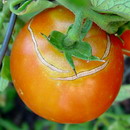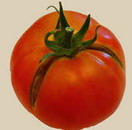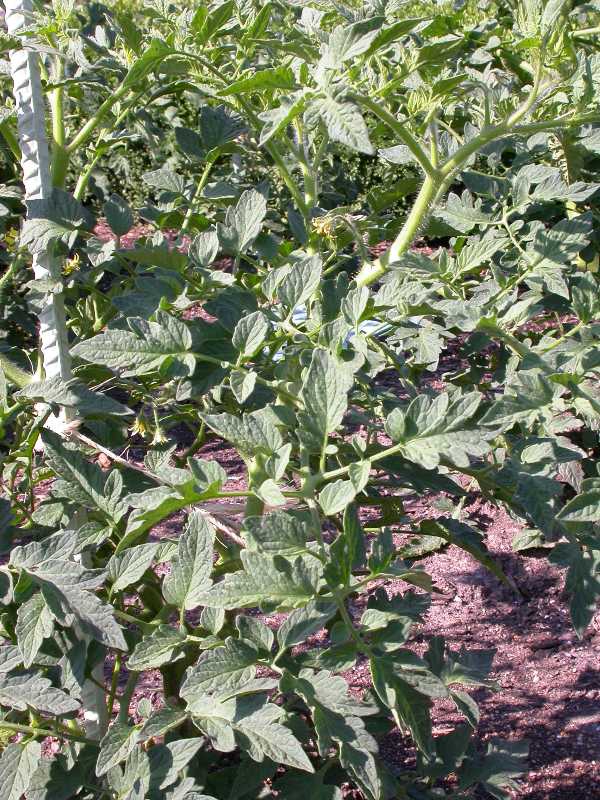Also see:
Tomato irrigation problemsWater is important to all plants, but too much or too little can hurt the quality of fruit. Tomatoes need sufficient amounts of water throughout the growing season to thrive and produce fruit. Water tomatoes deeply once a week, soaking about 6 to 8 inches of the soil. To retain moisture and keep weeds down, apply a layer of mulch, such as straw or composted leaves, during hot summer months to help retain soil moisture.
How often should tomato plants be watered?
Vegetables, including tomatoes, need to mature quickly and the watering schedule should be as consistent as possible. Too little water will stress them out and can set them back beyond recovery. Tomatoes as well as beans, beets, radishes and cucumbers either experience a substantial drop in quality or just stop growing altogether if they don't get enough water. Plants that are consistently over-watered, on the other hand, often appear weak and spindly and are more prone to disease.
Watering scheduleGerminating seeds should be in slightly moist soil, but never wet. Seedlings do fine if the top 1/4 inch of the soil is dry, as long as the soil below that is moist. As the plant matures, deep water the base of the plant until the water begins to pool. Never allow the plant to sit in standing water for more than a minute or two. As the growing season winds down, so should the amount of water. Because tomatoes like a warm, moist environment, a thick layer of mulch will help to hold in moisture, as well as prevent and slow the spread of disease and weeds.
Too much waterLike all garden vegetables, tomatoes create a steady exchange of oxygen and carbon dioxide. Too much water prevents this exchange, causing your plants to drown. Periods of drought followed by heavy rain followed by another drought, causes cracks and splitting in the tomatoes. Once the tomatoes begin to ripen, they shouldn't be over-watered as it puts the fruit at risk for cracking. Cherry tomatoes are particularly prone to splitting after too much water, particularly if they have just gone through a dry spell. If you expect a heavy rain, pick all the ripe tomatoes before they split.
Too little waterIf you are seeing blossom-end rot, it's usually because your tomatoes haven't been watered or it hasn't rained; essentially a sudden drop in the soil's moisture level. The soil should never dry out completely during the growing season. A good way to test the moisture level is by sticking your finger all the way into the soil, you may not feel moisture at the base of your finger, but you should always feel moisture at the tip.
Companion plantingWhen planning a vegetable garden, it's so important to use companion planting to make sure all of the plants get what they need regarding water, fertilizer, sun and soil. Tomatoes can be planted with asparagus, basil, broccoli, carrots, cauliflower, mustard, onions, parsley, rosemary and sage. All of these plants need similar amounts of water, sun and space.
How much should you water tomato plants every day?
Tomato plants thrive in full sun in humus-rich, well-drained soil with a pH between 6.0 and 6.8. Although tomato plants can tolerate slightly dry soil, they perform best when the soil remains evenly moist, as uneven watering can cause blossom-end rot and cat-facing in tomatoes. Knowing exactly how much water they need can be a challenge, but by following simple guidelines you can provide your tomato plants with the right amount of water.
SeedlingsDetermine the amount of water your seedlings require by following their lead. Initially, they may require as little as 1/4 cup of water, but as they grow larger, their water needs increase. Watering them until water runs freely through the bottom of the pot and checking them throughout the day give you a good indication of the amount of water they need. Typically, if the soil dries in less than 24 hours, your tomato plants require either more water or transplanting to a larger pot.
Tomatoes in containersFull-grown tomatoes grown in containers often require daily watering. The exact amount needed may range from a quart to a gallon or more, depending on the rate of growth, weather conditions and the pot size. As a rule, watering your tomatoes until water runs freely through the bottom of the pot and again when the soil feels dry to the touch 1 inch below the surface provides them with the water they need to thrive.
Tomatoes in the soilBecause tomatoes grown in the soil can send their roots deep into the soil when the surface soil dries, they often require less frequent watering than tomatoes grown in containers. However, deep watering to moisten the soil to the root level once or twice a week is preferred to daily light watering. Wetting the surface of the soil without saturating the soil at the root level encourages tomato plants to form roots near the surface of the soil, compromising the support system of the plant. As a rule, tomato plants require 1 to 2 inches of water a week.
ConsiderationsWeather conditions, plant size and growth rate, and the soil the tomato plant is grown in all affect the amount of water your tomato plant needs. Your plants require more water during hot, dry spells and periods of active growth than they do during wet weather or when the plants are young. How well the soil drains and its water-holding capacity also affect the amount of water they need. Observing your tomato plants throughout the day gives you important clues to their watering needs. Healthy tomato plants that wilt excessively or soil that feels dry to the touch indicate that more water is needed.
How much water does a tomato plant need a day?
The key to keeping tomato plants healthy and hydrated is to maintain an even and consistent soil moisture level. This means your plants should never dry out or live in sopping wet, swampy conditions. Evenly moist soil is your goal. The daily amount of water it takes to keep the soil around your tomato plants evenly moist depends on a variety of factors, such as the temperature and where you plant the tomatoes. If you keep your soil moist most of the time, you'll be providing the correct amount of hydration.
SeedlingsTomato seeds and seedlings need to be kept moist, but never wet, at all times. Because they're typically placed in small seed-starting containers or seedling trays, you'll need to check their moisture levels more than once daily to ensure they haven't dried out. Small seedlings can be misted several times a day with a spray bottle. The amount of water will vary depending on temperature, container size, air flow and humidity. Keep the soil moisture levels as even and consistent as possible. If you notice the soil is too moist, increase air flow in the area, and hold off on watering again until the soil is on the drier side of moist, but not completely dried out.
Container plantsContainer plants have different watering needs than garden tomatoes. The containers tend to heat up more quickly. This increased soil temperatures causes water to evaporate at a fast rate. The containers also can't hold as much water as the soil surrounding tomatoes planted in the ground. You'll likely need to water these plants more than once per day. Start with a morning watering, then check on your containers throughout the day to see if you need to add afternoon and evening waterings.
Garden plantsTomatoes in gardens have an advantage over container plants -- they can spread their roots out far and deep in search of water. Even so, the same rule of thumb about even soil moisture applies. Tomato plants need about 1 to 1 1/2 inches of water each week to fruit, according to Ohio State University. There's no need to measure, so long as you maintain an even soil moisture. At the beginning of the growing season, this may mean watering in the morning until the soil is thoroughly damp and remains damp all day. As temperatures rise, you'll likely need to water your plants in the morning, then again in the evening to maintain consistently moist soil.
TipsTo help retain soil moisture, add a few inches of organic mulch to the top of your soil. The mulch will help slow down water evaporation. Watering in the morning and evening also helps prevent evaporation. Remove weeds as they crop up so they don't steal water away from your tomatoes. If you have access to a drip irrigation system, you'll have an easier time keeping your soil consistently moist, but installing one isn't a necessity.
Can you water your tomato plant right after you plant it?
Proper watering technique is one of the most important components of growing tomatoes. Watering too much or too little can lead to poor plant health and diminished yield. During planting, it is important to give the plants plenty of water to help them establish roots in the new soil.
Planting tomatoes in the groundWhen planting tomatoes directly into the ground, it is best to plant while the soil is moist but not soggy. This allows the initial watering to drain more easily through the soil. Directly after planting, water the area around the base of the plant until it begins to puddle on the surface, then allow the standing water to soak into the soil. Water once more, again, allowing to puddle slightly before draining through. This will ensure the plant has enough water while it sends its roots in the new soil.
Planting tomatoes in potsTomatoes grow well in containers and you should care for them in a similar way as when you plant them directly into the soil. After planting, soak the soil surrounding the plant thoroughly until the water begins to run out the bottom of the container. This means the water has drained all the way through the soil.
Future water careIn general, tomato plants thrive when watered deeply and infrequently. Supply 1 to 2 inches of water per week, whether through rain or supplemental watering. Each time you water, soak the soil thoroughly to allow water to reach the roots deep in the soil. Potted tomato plants require more frequent watering than those in beds because the soil loses moisture more quickly.
Water-related problemsIncorrect watering is a main cause of disease in tomato plants. Light, frequent watering will lead to weak root systems and poor plant health. Inconsistent water, whether to little or too much, can cause blossom-end rot, a disease which causes large dark spots on the bottoms of the tomatoes. Mulching the area around tomato plants can help to maintain a more even level of soil moisture.
How much water does a tomato plant need in its life time?
Tomatoes thrive on routine, including a regular watering schedule. Provide at least 1 inch of water per week throughout the life cycle of the plant, increasing to 1.5 inches during the hottest months. When properly cared for, these annuals are capable of producing 10 to 15 pounds of tasty, nutritious fruit that matures in 65 to 100 days, depending on variety. An inch equals 1/2 gallon of water per square foot or 30 gallons for a 60 square-foot plot.
Moisture mustsThoroughly soak soil to a depth of 5 to 8 inches to encourage strong roots and calcium circulation. It's better to use a drip hose or water individual plants at the base than to use spray attachments that wet the leaves. Morning is ideal for watering, especially if you're using a sprinkler, because foliage has time to dry before nightfall. Dark, damp conditions invite bacterial and fungal diseases.
Adjusting amountsPlants flourish in daytime temperatures of about 75 degrees Fahrenheit and nighttime temperatures of about 68 degrees. They're thirstier during peak production. Drought and heat waves may also warrant additional water. Dig down a few inches or lift the container. If the soil feels crumbly and light, plants are low on water. Tomatoes are sensitive to shifts in moisture. Blossom-end rot and growth cracks may result from sudden decreases or surges, such as going from dry weather to heavy rain.



